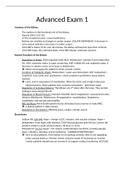Advanced Exam 1
Anatomy of the Kidney:
- The nephron is the functional unit of the kidney.
- Normal GFR is 120-125.
- If 75% of nephrons quit = renal insufficiency.
- Kidneys are sensitive to changes in cardiac output. VOLUME DEPENDENT. A decrease in
urine output indicates a decrease in cardiac output.
- If the SBP is below 70 for over 40 minutes, the kidney will become hypo then ischemic.
- If the SBP drops, the arterioles dilate. If the SBP elevate, arterioles constrict.
Normal Functions of the Kidney:
- Regulation of Water: Thirst regulates body fluid. Aldosterone- excretes K and reabsorbed
NA. ADH- reabsorbs water, is water conserving. ANP- inhibits NA and reabsorbs water. A
decrease in volume causes as increase in aldosterone.
When encouraging the patient to drink, provide a GOAL.
- Excretion of Metabolic Waste: Reabsorbed = water and electrolytes. NOT reabsorbed =
creatinine, urea, lactic acid, and ketones. Check creatinine and BUN to assess kidney
function
Lactic acid is a byproduct of metabolism. When the lactic acid is high in decrease
kidney function, these patients have soreness everywhere. *give them water.
- Regulation of Acid-Base Balance: The kidneys are 2nd place after the lungs. They excrete
hydrogen and reabsorb bicarb.
- Regulation of Blood Pressure: Maintain VOLUME. Renin-Angiotensin- vasoconstricts then
releases aldosterone. Aldosterone. Prostaglandins- vasodilatation. Bradykinins-
vasodilation and vascular permeability.
- RBC Synthesis: Renal Erythropoietin Factor stimulates bone marrow to make RBCs.
A dialysis patient is often anemic.
- Regulation of Electrolytes: effecting neuro, cardiac, mental, and GI.
Electrolytes:
- Sodium NA: 135-145. Hypo = change in LOC, seizures, and vascular collapse. Hyper =
dehydration. Treat hyper with diuretics, D5W because glucose pulls NA out. Correct the
problem slowly to avoid cerebral edema. 48 hours or more.
- Potassium K: 3.5-5.2. Hyper = MI, chemo, autotranfusion (we did it), crushing injuries.
Hypo = diuretics, diarrhea, and GI suctioning. *CARDIAC DYSRHYTHMIAS*
No K to renal patients, if the kidney is not working correctly, they’re not regulating
levels causing build up. Monitor closely, and give slowly. Pt should be on monitor.
Cardiac patients should have an increase K to support cardiac functioning. NO PUSH.
, - Calcium Ca: 8.5-10.2. Needed for nerve impulses, cardiac contraction, blood clotting,
and bones and teeth growth. Hypo = laryngospasm (AIRWAY), and respiratory collapse.
Transfusions decrease Ca. Basic Metabolic Panel is not accurate. A decrease in Ca
indicates a decrease in albumin.
Chovskeys-
Trouvosels-
- Magnesium Mg: 1.8-2.4. Hyper = decease reflexes, hypertension, and cardiac
dysrhythmias. Hypo = increase in muscular and CNS activity.
K needs Mg. Give Mg first so K can be transported into the cells.
- Phosphorus: 2.5- 4.9. Where Ca is… Phos is NOT! Opposite s/s as Ca.
Ask our Patient: current problem, what’s their normal, how much fluid do you drink daily, what
meds do you take, other health issues, and family history.
Nephrotic Syndrome: (1530 BOX 70-5)
- Causes- Glomerulonephritis, glom injury, neoplastic disease, diabetes, and altered liver
function.
- Symptoms- Proteinuria, hypoalbuminemia causing EDEMA, weight gain, dyspnea, HTN,
orthostatic, ascites, decrease output
- ACUTE = related to medications. CHRONIC = related to processes of disorders over time.
- Interventions- TX the underlining cause related to meds. 24 hour urine catch daily
weights, abdominal girths, I&O, monitor electrolytes. ORDERS – diuretics, steroids, low
NA and protein diet, replace albumin.
Acute Kidney Injury:
- A sudden rapid decline of glomerular filtration. Reversible if diagnosed and treated early.
Retaining waste, and causes a rise in creatinine by more than 0.5mg.dl or 50% about
baseline.
- Classification:
-Pre-Renal: #1 cause of AKI. Impaired renal perfusion. Decrease GFR. Causes =
Hypovolemia- SHOCK, blood loss, diabetes, and misuse of diuretics.
Hypotension/Perfusion- CHF, decreased cardiac output, or clamping of renal
artery (during abdominal aneurysm surgery)
Intrarenal: decrease GFR and solute filtration. Causes = SEPSIS, trauma,
inflammation, glomerulonephritis, and vascular disease.
-->amikacin for sepsis patients.
-->Going to CT? Are you on dialysis? *contrast!
-Post-renal: RARE! Clots, stones, crystals, malignancy, endometriosis, prostate
disease, bladder mass, and urethral stricture.
- Symptoms: findings aren’t bad until renal dysfunction gets severe. Malaise, n/v, weakness,
altered LOC, dyspnea, chest pain, oliguria, metallic taste, HA, weight gain, itchy dry skin.
, -Phases of AKI: pg. 1540
Oliguria: 1-3 weeks. Begins one day after hypotensive event. Will NOT respond to a fluid
challenge. (Urine Output 100-400ml/24hrs)
Diuresis: 2-6 weeks after. Volume loss of at least 3-4L/day. Loss of Na and K. BUN decreases and
because normal kidney function is reestablished.
Recovery: 3-12 months. 30% do NOT recover GFR or tubular function.
-Diagnostics: Lab assessment (know #s), Radiology to rule out mass, fluid collection, or
obstructions, check structural formation.
Chronic Kidney Disease: pg. 1554
- Slow loss of kidney function, progressive and irreversible, no early s/s it’s a patient
organ, make take months-years to occur, in the final stage kidneys are unable to remove
excess waste and fluids.
- Stages: pg. 1547
- Causes: Diabetes and Hypertension. Autoimmune, polycystic kidney disease,
glomerulonephritis, kidney stones, infections, trauma.
- Symptoms: loss of appetite, malaise, dark urine, HA, itching, weight loss, and N.
- Tests: LOOK AT THE URINE. 24hr creatinine clearance = detects progression of kidney
disease. Ultrasound, and biopsy.
Treatment for AKI & CKD:
- AKI treat the underlying cause, support and improve renal function, and dialysis.
- CKD maintain body balance, and dialysis.
- Fluid Balance: Hypovolemia treat with volume & with transfusions if anemic.
Hypervolemia diuresis, fluid restriction, and dialysis. Possible vasoactive meds to
increase cardiac output EX. Dabutamine, norepinephrine, and dopamine- give in low
doses to increase urine output.
- Metabolic Balance: Too much base, and they’re not secreting it (same with K). HyperK-
diuretics, glucose, insulin, bicarb. HypoNa- fluid restriction and kayexalate. HypoMg-
replace it. HypoCa- replace it with vitamin D. HyperPhos- phoslow, give with meals so
you poop out phos.
- Hematologic- if anemic, give iron/transfusions. Antacids and H2blockers to stop retaining
acid and prevent GI bleed.
- Diet 71.8: Protein, fluid, K (NO OJ), Na, and Phos.




